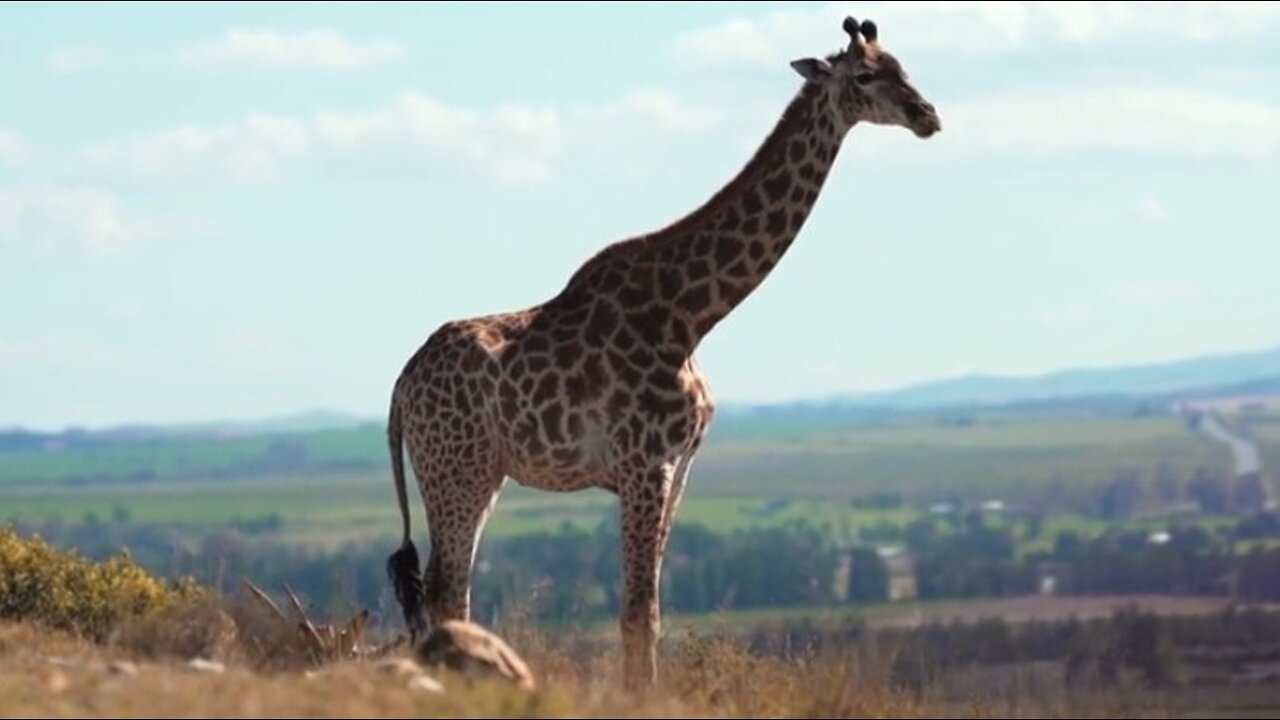Premium Only Content

"Giraffes: The Tallest Creatures on Earth"
The giraffe (Giraffa camelopardalis) is the tallest land animal on Earth, known for its long neck, unique coat patterns, and gentle demeanor. It is native to various parts of Africa, where it roams savannas, grasslands, and open woodlands. Here’s a detailed look at the giraffe:
Physical Characteristics:
Height: Male giraffes can reach up to 18 feet (5.5 meters) tall, while females can grow up to about 14 feet (4.3 meters).
Neck: The giraffe’s neck alone can measure around 6 feet (1.8 meters). Despite their long necks, giraffes have the same number of neck vertebrae as most mammals (seven), but each vertebra is much larger.
Weight: Adult males weigh around 2,800 pounds (1,270 kg), while females weigh around 1,800 pounds (820 kg).
Coat Patterns: Giraffes are known for their distinct coat patterns, which are unique to each individual, much like a human fingerprint. The patterns consist of irregularly shaped patches that can range from tan to brown, outlined by lighter lines.
Subspecies:
Giraffes are divided into several subspecies, and their classification is based largely on coat patterns and geographic range. Some of the recognized subspecies include:
Northern giraffe (Giraffa camelopardalis),
Southern giraffe (Giraffa giraffa),
Masai giraffe (Giraffa tippelskirchi),
Reticulated giraffe (Giraffa reticulata).
Each subspecies has unique coat patterns, with some displaying large, blocky patches, while others have smaller, more intricate patterns.
Habitat and Range:
Giraffes are mostly found in sub-Saharan Africa. They prefer open savannas and woodlands where they have access to their primary food source—acacia trees. Their range extends across countries like Kenya, Tanzania, Botswana, South Africa, and parts of Central Africa.
Diet:
Giraffes are herbivores, with a diet focused on leaves, flowers, and fruits, primarily from acacia trees. Their long necks and prehensile tongues, which can be up to 18 inches (45 cm) long, allow them to reach foliage that is inaccessible to other herbivores. Giraffes can consume up to 75 pounds (34 kg) of foliage per day.
Behavior:
Social Structure: Giraffes are social animals that typically live in loose herds. These groups can vary in size and composition, with males, females, and young mingling freely. There is no strict hierarchy, and individuals may move in and out of groups as they please.
Communication: Giraffes are generally silent, but they are known to produce a range of sounds, including grunts, snorts, and even infrasonic sounds that are inaudible to humans. These may be used to communicate over long distances.
Reproduction: Female giraffes give birth standing up, and calves endure a fall of around 6 feet (1.8 meters) at birth. Newborns are about 6 feet tall and weigh around 100-150 pounds (45-68 kg). Calves are weaned at about six months but remain close to their mothers for protection.
Fighting: Male giraffes sometimes engage in a behavior called "necking," where they swing their necks and heads at each other in combat to establish dominance or mating rights. This can involve powerful blows and may last for hours.
Predators and Threats:
Adult giraffes are generally safe from predators due to their size, but young calves are vulnerable to lions, leopards, and hyenas. Giraffes defend themselves by delivering powerful kicks with their long legs, which can kill or severely injure predators. Humans, however, pose the greatest threat to giraffes, as habitat loss, poaching, and fragmentation of their environment have led to declining populations.
Conservation Status:
Giraffes are currently classified as "Vulnerable" on the IUCN Red List, with certain subspecies being more at risk than others. Conservation efforts are focused on habitat protection, anti-poaching measures, and breeding programs in zoos and reserves.
Unique Adaptations:
Cardiovascular System: Giraffes have an extraordinary cardiovascular system that allows them to manage the challenges of pumping blood all the way up their necks. Their hearts can weigh up to 25 pounds (11 kg) and generate twice the blood pressure of an average mammal to ensure that blood reaches the brain.
Tongue and Saliva: The giraffe's tongue is not only long but also tough and covered with thick saliva, which helps protect it from the thorns of acacia trees.
Drinking Water: Due to their height and leg length, drinking water can be a challenge for giraffes. They must spread their front legs and bend down awkwardly to drink. This makes them vulnerable to predators, so they tend to drink quickly and cautiously.
Importance in Ecosystems:
Giraffes play a crucial role in their ecosystems. By feeding on tall trees, they help maintain the balance of the vegetation, preventing overgrowth in some areas and allowing for different types of plants to thrive.
-
 LIVE
LIVE
TheSaltyCracker
1 hour agoPipe Bomb Bull Sh*t ReeEEStream 12-05-25
12,476 watching -
 LIVE
LIVE
Sarah Westall
1 hour agoJobs Losses Hit the Millions, Real Estate Nightmare, Repo Markets, & more w/ Andy Schectman
609 watching -
 1:32:12
1:32:12
Glenn Greenwald
6 hours agoGlenn Answers Your Questions on an Un-American Candidate in TX, Escalating War with Venezuela, Trump's Loyalty to Miriam Adelson, and More | SYSTEM UPDATE #554
79.9K14 -
 3:49
3:49
Gamazda
4 hours ago $1.66 earnedABBA - Dancing Queen (Piano)
2.88K5 -
 1:03:20
1:03:20
BonginoReport
4 hours agoCNN’s Colorblindness Strikes Again! - Nightly Scroll w/ Hayley Caronia (Ep.191)
98.2K29 -
 1:26:55
1:26:55
The Daily Signal
3 hours ago $4.41 earned🚨BOMBSHELL: Minnesota Somali Fraud Scandal Gets WORSE, $8 Billion Lost, Gas & Oil Prices Plummet
8.76K6 -
 17:44
17:44
tactical_rifleman
9 hours ago $1.64 earnedMilitary's New Belt-Fed Machine Gun | MCR | Tactical Rifleman
5.91K5 -
 LIVE
LIVE
LFA TV
22 hours agoLIVE & BREAKING NEWS! | FRIDAY 12/05/25
538 watching -
 LIVE
LIVE
DBoss_Firearms
1 hour ago $0.39 earnedD'Boss Firearms is LIVE! Help me vote for the Gundies!
87 watching -
 3:14:14
3:14:14
Nerdrotic
7 hours ago $19.88 earnedHollywood PANICS! Netflix WINS Warner Bros | RIP Star Trek - Friday Night Tights 383
137K11